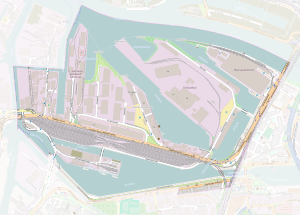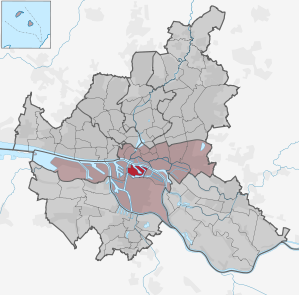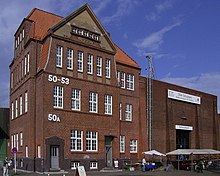Hamburg-Kleiner Grasbrook
|
Small Grasbrook district of Hamburg |
|
|---|---|
| Coordinates | 53 ° 31 '52 " N , 9 ° 59' 37" E |
| surface | 4.5 km² |
| Residents | 1108 (Dec. 31, 2019) |
| Population density | 246 inhabitants / km² |
| Post Code | 20457, 20539 |
| prefix | 040 |
| district | Hamburg-Mitte district |
| Source: Statistical Office for Hamburg and Schleswig-Holstein | |

The Kleine Grasbrook is a district in the Hamburg-Mitte district of the Free and Hanseatic City of Hamburg . It currently consists almost exclusively of facilities from the Port of Hamburg . Since the handling of goods through the use of containers in the downriver nearby container terminal has shifted, however, are many areas broke , has so long been a redevelopment of the area planned. In the past, it was intended as a central campus for the University of Hamburg and as a venue for the Olympic Games in 2024 or 2028 . According to current planning, a new residential area for up to 6,000 people and work opportunities for up to 16,000 employees are to be created here.
geography
The former inland island lies between the districts of Veddel in the east, Steinwerder in the west and Wilhelmsburg in the south. On the opposite side of the North Elbe , on the formerly connected island of Großer Grasbrook, is the HafenCity district , to which Hamburg city center is connected. The part of the name -brook indicates that it used to be a low-lying, humid and often flooded quarry land .
history
The name of the district comes from the former Elbe island Grasbrook , which has served Hamburgers as a pasture since the Middle Ages. In 1549 it was cut through by the construction of the New Trench , which was supposed to lead more water from the southern Elbe to the northern Elbe . The current course of the Norderelbe was created by another cut in 1604.
In the 19th century, the Kleine Grasbrook - now located south of the North Elbe - was combined with other islands such as the Schumacherwerder , raised to a suburb in 1871 and incorporated into the municipality in 1894. The neighboring Große Veddel was also included in the new district , while the Veddel district only includes the area of the former Kleine Veddel and the Peute .
Long before the incorporation, the Senate designated the Kleine Grasbrook as the first port expansion area south of the North Elbe. From 1838 canals and quays were created. With the Südwesthafen, which served as a petroleum port, the first port basin south of the Norderelbe was created in 1879. When the free port of Hamburg was created because of the Hamburg customs connection , the sailing ship port (1888), the Hansahafen (1893), the India port and the Oberland port (1894) followed as sea ports. The Vltava port (1887), Saale port ( 1888), Spreehafen (1890) and Klütjenfelder port were built for inland navigation at the same time . From the beginning of the 20th century, the Hamburg port railway opened up the area.
For the new port facilities, the previous residential buildings had to give way. Its inhabitants were resettled in areas north of the Elbe. There are still isolated residential developments on Harburger Chaussee.
The area at Moldauhafen was as a result of the lost World War I and then closed the Versailles Treaty of Czechoslovakia left in 1929 for use.
During the Second World War , 90 percent of the buildings on Kleiner Grasbrook were destroyed. Reconstruction and restructuring led to the India port and large parts of the southwest port and the sailing ship port being filled in. In 1978, HHLA's fruit and refrigeration center was opened in the area of the sailing ship harbor, and it has long been one of the most modern in Europe. Even today, at O'Swaldkai, fruits - especially bananas - are extinguished, stored at a temperature and distributed. To the north of the fruit center is the terminal of the HHLA subsidiary UNIKAI, which mainly handles RoRo ships there . The HHLA overseas center built in 1967 at the Moldauhafen was considered the largest collection and distribution shed in the world when it was opened. In 2003, HHLA and Rhenus formed a joint venture ; this operated the Überseezentrum until the mid-2010s. Since then, the site has not been used and, like the areas on the Vltava and Saale ports, is to be rededicated for residential construction with business areas as part of urban renewal .
Failed Olympic application
In the summer of 2014 it became known that areas for venues and the Olympic Village were being planned on Kleiner Grasbrook . If Hamburg had been awarded the contract after applying to host the 2024 or 2028 Olympic Games , larger infrastructural measures would have been necessary. To do this, a number of companies would have had to be relocated from the outer eastern area of the Port of Hamburg, including several locations of HHLA companies (e.g. the fruit and refrigeration center). The Hamburg Harbor Enterprise Association (UVHH) reckoned with a good 2000 employees who would have been affected by relocation. He also had concerns that the time available for planning and relocating to areas that had not yet been prepared would not have been sufficient. On November 29, 2015, the major project was rejected by the Hamburg Olympic citizenship referendum with 51.6% no votes compared to 48.4% yes votes. The turnout of eligible citizens in this referendum was 50.2%.
Planned residential area
On September 12, 2017, the Senate announced that a new "district" with the name "Grasbrook" is to be built on parts of the Kleiner Grasbrook district. This concerns the southern bank area of the Norderelbe opposite the eastern Hamburg HafenCity as well as the bank areas on both sides of the Vltava and Saale harbor, which corresponds to an area of 46 hectares. The site of the previous Überseezentrum is to be completely incorporated into it. The new city district is located opposite on the south bank of the Norderelbe and is intended to implement the urban planning "leap across the Elbe" that has been forced for a long time. Apartments for around 6,000 residents and up to 16,000 jobs as well as shopping facilities, a primary school and daycare centers are planned. A station on the U4 underground line in the “Hafentorquartier” (which will not be built until after the development) and several bus stops are planned for the southern part . A development of the Veddeler Marktplatz in the neighboring district of Veddel to the east, which is also in the planning stage, is intended to bring these two districts together. The Unikai terminal is to be retained (for the next few decades) and the lease is being extended here.
Specifically, the new development area is to be divided into three quarters. In the western area of the area of today's Übersee-Zentrum , the Moldauhafenquartier and in the eastern area, towards the district of Veddel, the Freihafenelbquartier are to be built. The third quarter called Hafentorquartier is to be built on the southern bank of the Vltava harbor and around the Saale harbor . The area at O'Swaldkai should continue to be available for port use. The area of the Übersee-Zentrum is to serve as the location for the newly established German Harbor Museum .
politics
For the election to the citizenship , the Kleine Grasbrook belongs to the constituency of Billstedt-Wilhelmsburg-Finkenwerder . The 2015 state election led to the following result:
| Citizenship election |
left | Green | SPD | Political party | AfD | CDU | FDP | Pirates | Rest |
|---|---|---|---|---|---|---|---|---|---|
| 2020 | 39.9% | 26.7% | 10.2% | 6.3% | 3.0% | 2.6% | 2.4% | 1.2% | 7.7% |
| 2015 | 31.9% | 15.8% | 19.2% | 11.4% | 1.6% | 3.2% | 2.6% | 10.8% | 3.5% |
| 2011 | 19.3% | 19.2% | 36.1% | 5.3% | - | 5.3% | 1.6% | 12.0% | 1.2% |
(Result for Kleiner Grasbrook and Steinwerder together)
Economy and Infrastructure
Due to its location, the district is almost exclusively characterized by the port. The Hamburg Port Authority (HPA), formerly the Office for Electricity and Port Construction , is the state authority responsible for the entire port area (not just on Kleine Grasbrook). It is also subordinate to the Hamburg port railway , which operates rail transport in the port area. The Hamburg-Süd port station is located on Kleiner Grasbrook .
traffic
On the south-eastern edge of the district is the Veddel S-Bahn station , which is served by the S 3 ( Pinneberg - Altona - Hauptbahnhof - Harburg - Neugraben - Buxtehude - Stade ) and S 31 (Altona - Hauptbahnhof - Harburg) lines. In addition to the VHH bus line 256, which connects the Kleine Grasbrook from the Veddel S-Bahn station and the old Elbe tunnel , the HADAG ferry line 73, which comes from the St. Pauli Landungsbrücken , plays for other port ferries and the dinghy guide services the Kleine Grasbrook only plays a subordinate role, as the pier is located on the south-western edge.
Authorities
In addition to the HPA, customs play a major role in the district. Large parts of the main customs office in Hamburg Harbor are located across from Shed 50 and on Veddeler Damm . The three customs clearances of the Hamburg-Waltershof customs office responsible for the eastern part of the port are located opposite Schuppen 50 ( Australiastraße ), on Tunnelstraße on the border to Veddel and at the northern end of the Elbe bridges ( Zweibrückenstraße ).
Culture and sights
Museums
- In the port museum in Schuppen 50, a branch of the Museum of Labor , historical work and handling equipment, cultural history exhibitions and, in particular, objects and memories of professions that have died out in the port can be viewed. The shed was built from 1908 to 1912 and is one of the last wooden sheds in the harbor today. The head building (photo) shows elements of Hamburg's reform architecture of that time.
- At the outside facilities at the Bremer Kai / Hansahafen, handling and steam facilities on land and on water as well as historical ships are exhibited. a. Van Carrier , the Saatsee steam floating crane , some box barges and the general cargo ship Bleichen . The Hamburg Maritime Foundation is responsible for looking after some of the ships .
- Also behind the shed on the Bremer Kai, the Friends of the Historic Port Railway Association exhibits restored vehicles from the Hamburg Port Railway and other industrial and works railways.
Buildings
Despite the constant modernization, there are also older evidence of the Hamburg harbor architecture on the Kleiner Grasbrook:
- One of Hamburg's oldest storehouses is located at the Saale harbor on Dessauer Strasse , Lagerhaus G , which served as a satellite camp of Neuengamme concentration camp during World War II .
- Directly opposite is a very old shed that is still in use today, which dates from the early days of the port railway ( picture )
See also
- List of streets and bridges in Hamburg-Kleiner Grasbrook
- List of cultural monuments in Hamburg-Kleiner Grasbrook
- List of stumbling blocks in Hamburg-Kleiner Grasbrook
Web links
Individual evidence
- ^ Authority for Science, Research and Equality: Perspectives for the University of Hamburg. hamburg.de, March 31, 2009, accessed on September 15, 2017 .
- ↑ Eckhard-Herbert Arndt: Senate sacrifices port area for housing construction · Czech Republic gets new logistics area . In: Daily port report of September 13, 2017, p. 16
- ^ German Olympic application . Spiegel online from September 1, 2014, accessed February 10, 2015
- ↑ Authority for Urban Development and Housing: Masterplan Olympia: Compact games in the city. hamburg.de, October 1, 2015, accessed on September 15, 2017 .
- ↑ Eckhard-Herbert Arndt: “Companies need more time” · UVHH President Gunther Bonz on the Olympic Games in Hamburg . In: Daily port report of February 3, 2015, p. 2
- ↑ Senate Chancellery Hamburg: A new district for Hamburg. hamburg.de, September 12, 2017, accessed on September 15, 2017 .
- ^ The new district of Grasbrook. (PDF) HafenCity.de, October 2017, accessed on October 17, 2017 .
- ↑ Eckhard-Herbert Arndt: "ÜZ" gives way to the German port museum · The million dollar project is to be built on Kleiner Grasbrook . In: Daily port report of December 20, 2017, p. 2
- ↑ http://www.wahlen-hamburg.de/wahlen.php?site=left/gebiete&wahltyp=3#index.php?site=right/result&wahl=973&gebiet=50&typ=4&stimme=1&gID=4&gTyp=2








